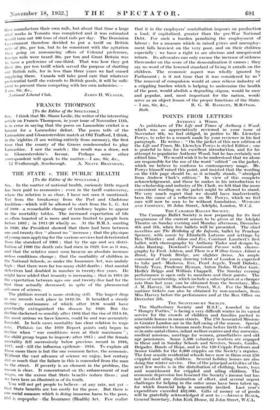THE STATE v. THE PUBLIC HEALTH
[7'o the Editor of the SeEcr.troit.] Stii,--In the matter of national health, curiously little regard has been paid to economics ; even in the tariff controversy, where the relation is so clear, I have not seen it mentioned. Yet from the breakaway from the Peel and Gladstone tradition—which- will be allowed to start from the L. G. Act of 1888—a remarkable change of tendency begins to appear in the mortality tables. The increased expectation of life so often boasted of is more and more limited to people born before 1895; in 1911-20 wholly so. At the A.M.A. meeting in 1980, the President showed that there had been between one and twenty-five "almost no " increase ; that the physique of young men applying for the various services had deteriorated from the standard of 1901 ; that by the age and sex distri- bution of 1900 the death rate had risen in 1929, low as it was, and that the relative must soon.beconie an absolute increase unless conditions change ; that the morbidity of children in the National Schools, as under the Insurance Act, was unduly high ; that there were far too many child deaths ; that mental defectives had doubled in number in twenty-five years. Ile might have added that insanity is increasing ; that in 1911-20 the expectation between ages one and twenty-five had for the first time actually decreased, in spite of the phenomenal - advance of science.
The phthisis record is more striking still. The hugest drop in any records took place in 1842-50. It heralded a steady decline ; continuance of which after 1896 would have Practically extinguished the disease by 1920. But the decline slackened so sensibly after 1896 that the rise of 1914-18, the most serious we have known; could be and was accurately foretold. In both cases mortality has clear relation to wage rate. Phthisis (as the 1919 Report points out) began to decline when " war conditions were at their maximum " ; the child group began to improw after 1915; and the female mortality fell successively below previous record in 1916, 1917, and—till the influenza epidemic-1918. To explain all these cases there is but the one common factor, the economic. Without the vast advance of science we enjoy, last century did so much that the failure in this is concealed from the man in the street. If Poverty is an element in the problem, the reason is clear. It concentrated on th3 enhancement of real wages, on the axiom that State lx nefits reduce them ; and we have here an illustrati in of its truth.
You will not get people to . believe—at, any rate, not yet— that State benefits are too costly for the poor. But there is one social measure which is doing immense harm to the poor, .1111d is unpopular —the Insurance (Health) Act. Few realize
that it in the employers' contribution imposes on production a load, if capitalized, greater than the pre-War National Debt. For such a burden penalizing the employment of labour ; for a measure which in raised prices and unemploy- ment falls heaviest on the very poor, and on their children especially ; we have a right to see obvious and unequivocal return. Its advocates can only excuse the increase of sickness thereunder on the score of the demoralization it causes ; they say no word of the lowered standard of living it entails on the children. The economic aspect was wholly ignored by Parliament ; is it not time that it was considered by us ? The removal of compulsion would at once relieve industry of a crippling burden which is helping to undermine the health of the poor, would abolish a degrading stigma, would be easy and popular, and, most important for the nation, would serve as an object lesson of the proper functions of the State.
































































 Previous page
Previous page